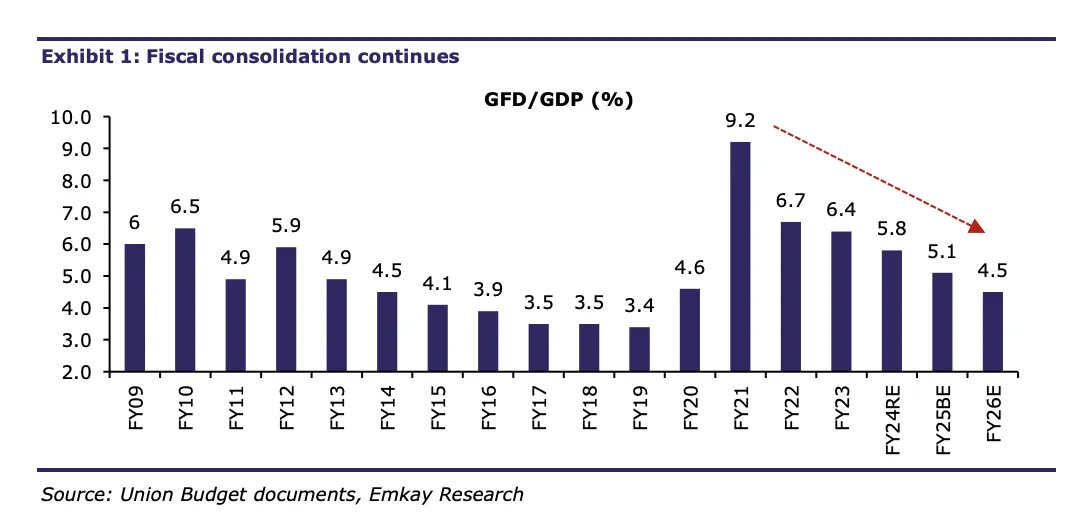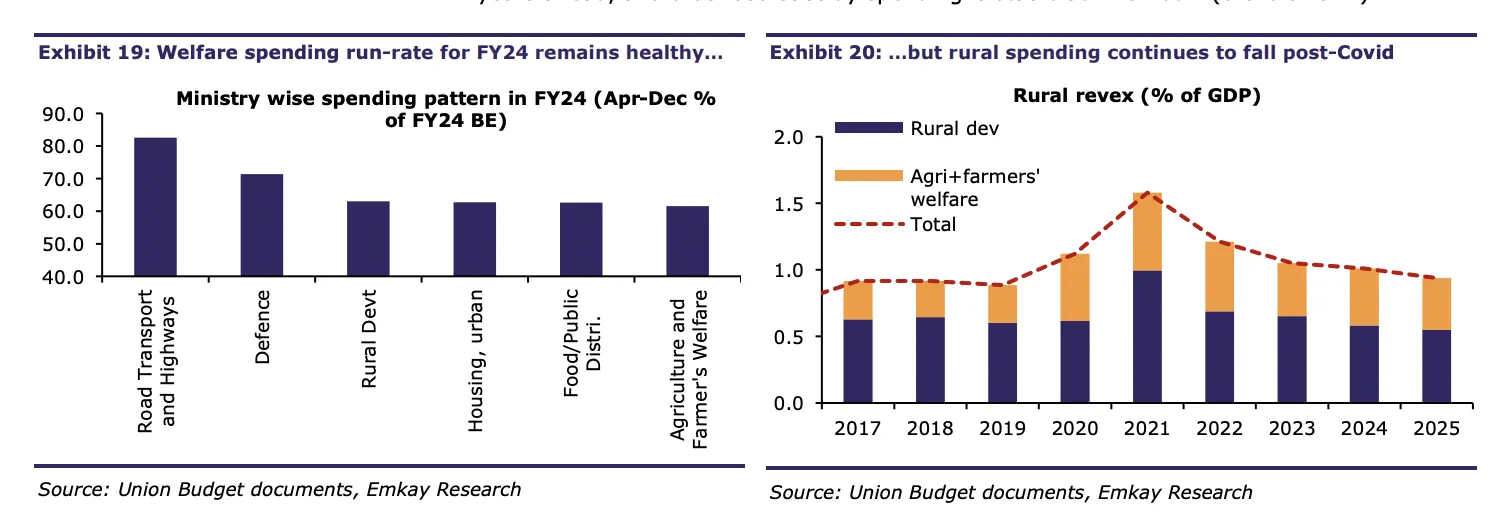Top Sectors to Invest in After the Interim Budget
The interim budget may have fallen short of big bang announcements. Still, the policy prerogatives and spirit have remained. In a nuanced approach, it delicately balances fiscal prudence with the underpinnings of growth, signaling a strategic pivot towards sustainable economic development rather than opting for short-term populism. This budget paints a picture of restraint and measured optimism, focusing on the long game in financial planning.
Despite the absence of headline-grabbing reforms, the interim budget subtly lays a fertile ground for sectoral growth. It hints at a promising landscape for sectors like banking and financial services, infrastructure, and renewable energy, which are positioned to benefit from the government’s targeted spending and policy support. This approach suggests a clear pathway for investors, pointing towards sectors likely to be at the forefront of India’s growth trajectory in the coming years.
The budget underscores a commitment to maintaining economic stability while quietly setting the stage for sectoral shifts that could define the next phase of India’s economic evolution. Let’s delve into the sectors that stand to gain in this carefully crafted fiscal environment, offering insights for discerning investors looking to navigate the post-budget landscape.
Fiscal Consolidation: A Key Highlight

At the core of this year’s interim budget is the government’s pronounced focus on fiscal consolidation—an endeavor to tighten the fiscal deficit and borrowing reins. The government has committed to a significant reduction in the fiscal deficit, targeting a consolidation to 5.1% in FY25 from the highs of 5.8% in FY24. This move exceeds market expectations and signifies a strong commitment to maintaining fiscal health. A sharp reduction in government borrowing for FY25 is planned, with gross borrowing down by Rs 1.3 trillion to Rs 14.1 trillion and net borrowing at Rs 11.75 trillion. This strategic cutback is poised to have a positive ripple effect on the economy.

Impact of Reduced Fiscal Deficit on the Economy
- Bond Yields: The anticipated reduction in bond yields, stemming from lower borrowing, is expected to foster economic expansion. The continued dip in yields is a bullish signal for economic growth.
- Capital expenditure: (Capex) for FY25 is set to increase by 14% to Rs 11 trillion, indicating heightened investments in key areas such as railways, roads, housing, and technology. This increase, although lower than previous estimates, aligns with the government’s growth and development objectives.
- Non-Populist: The budget is notably non-populist, with a conservative growth in revenue expenditure and rationalized subsidy spending. There is nothing incremental to induce rural demand. Notable allocations include increased funding for health, electronics, rural development, and renewable energy, suggesting a balanced approach to spending with an eye on fiscal health.
- Sustainability: Sustainable development is a key theme, with the government outlining plans to achieve its net-zero emission target by 2070. Initiatives include viability gap funding for wind energy, coal gasification, and support for the e-vehicle ecosystem, indicating a long-term commitment to environmentally sustainable growth
Top Sectors to Consider for Investment
Banking and Financial Services
The interim budget’s careful financial management is great news for banks and financial services. With the government cutting its deficit and borrowing less, interest rates on loans (bond yields) have gone down. This means cheaper loans for people and businesses, which is good for banks because it encourages more borrowing and investing.
Also, the government plans to help people buy houses and invest in solar energy. This creates more opportunities for banks to lend money for these projects, making the banking sector more robust and diverse. Lower interest rates and new investment areas like housing and renewable energy mean banks can lend more safely and profitably.
In simple terms, the budget creates a better environment for banks to do business, offering cheaper loans and more reasons for people to borrow, which could lead to a healthier economy and more stable banks.
Infrastructure
The interim budget has earmarked steady capital expenditure towards vital infrastructure sectors like roads, railways, and urban development. This focused investment is a clear signal of the government’s intention to bolster the country’s infrastructure backbone, which is essential for economic growth and development. With an increase in capital expenditure, there’s a direct impact on companies operating within these sectors. Businesses involved in construction, engineering, and materials stand to benefit significantly from the government’s push. This investment not only promises to improve the nation’s infrastructure but also opens up numerous opportunities for companies to participate in large-scale projects. As these sectors receive a financial boost, the ripple effects are expected to be felt across the economy, enhancing connectivity, facilitating trade, and ultimately contributing to a more robust economic environment. This strategic allocation of funds highlights the sector’s potential for growth and the opportunities for investors looking into infrastructure-related stocks or ventures.

Logistics
The interim budget has earmarked substantial investments for infrastructure development, particularly under the PM GatiShakti initiative, which aims to bolster the country’s logistics backbone. A significant portion of the budget is allocated towards enhancing roads, railways, and the development of airports, heliports, and advanced landing grounds. This strategic investment is expected to streamline logistics operations, reduce transportation costs, and improve connectivity, offering a substantial boost to rail and road transport companies.
The expansion of airports and other aviation facilities highlights a focus on improving air connectivity, which is crucial for the logistics sector, especially for the faster movement of goods and services across the country and beyond. Companies operating within the rail and road transport sectors stand to benefit from these initiatives, as improved infrastructure can lead to increased efficiency, reduced operational costs, and potentially higher profit margins. Overall, the logistics sector is poised for growth, driven by these targeted investments and the positive momentum they are expected to create in the transportation and distribution networks.
Metals & Mining
The Metals and Mining sector is set for a significant uptick following the interim budget, thanks to increased capital expenditures (capex) and targeted government initiatives. Key among these is the heightened focus on boosting steel demand, alongside ambitious plans such as interlinking rivers and the Jal Jeevan Mission. These initiatives are expected to have a direct and positive impact on the demand for metals, particularly benefiting pipe companies and steel producers.
The government’s commitment to infrastructural projects like river interlinking and ensuring water supply to all households under the Jal Jeevan Mission will require substantial amounts of steel and pipes. This demand surge will provide a robust boost to the sector, encouraging higher production levels and potentially leading to expansion and new investments within the industry. For steel producers and pipe companies, this translates into a period of growth and profitability, underscored by the government’s push towards infrastructural development and sustainability projects.
Energy
The energy sector’s outlook from the interim budget appears neutral, with a strong emphasis on sustainable development. Noteworthy initiatives include coal gasification and liquefaction, alongside bolstering the electric vehicle (EV) ecosystem, indicating a strategic pivot towards cleaner energy sources and technologies. These measures are set to have varying impacts across the sector. For oil marketing companies, the transition might present challenges as the focus shifts away from traditional fuels. However, it opens up new avenues for investments in renewable energy and related infrastructures, like charging stations for EVs, potentially benefiting companies involved in these domains. The government’s sustainable energy agenda is likely to reshape the energy landscape, encouraging both traditional energy companies and new entrants to adapt and innovate in alignment with these emerging priorities.
Sustainable Development: A Core Focus
The interim budget places a strong emphasis on sustainable development, aligning with the government’s ambitious goal to achieve net-zero emissions by 2070. This focus is manifested through significant investments and initiatives aimed at fostering a green and sustainable economic growth model. Among the key areas targeted are renewable energy, electric vehicles (e-vehicles), and bio-manufacturing, each poised to offer substantial investment opportunities in the coming years.
Renewable energy projects, especially wind and solar, are set to benefit from viability gap funding and other financial incentives, making them attractive options for investors looking to contribute to a greener future. The push towards e-vehicles, supported by enhancements in manufacturing and charging infrastructure, opens up new avenues in the automotive and energy sectors, signalling a shift towards cleaner transportation options.
Furthermore, the promotion of bio-manufacturing aims to develop environmentally friendly alternatives to conventional materials and chemicals, highlighting the government’s commitment to sustainable industrial practices. These efforts collectively pave the way for a comprehensive approach to achieving environmental goals while also unlocking new economic potentials.
By focusing on these areas, the government not only aims to meet its climate targets but also to stimulate growth in sectors that are crucial for the future of sustainable development. This focus is expected to attract significant investments, driving innovation and creating jobs in green technologies and industries, thereby reinforcing the economy’s resilience against environmental challenges.
Conclusion
The interim budget’s strategic focus on sustainable development marks a pivotal shift toward green and clean energy, underscoring the government’s ambitious aim for net-zero emissions by 2070. By channeling investments into renewable energy, electric vehicles (EVs), and bio-manufacturing, the budget not only addresses environmental concerns but also opens up a spectrum of investment opportunities. These sectors are expected to see a surge in innovation and development, driven by supportive policies and funding. The emphasis on renewable energy and the EV ecosystem, in particular, highlights a long-term vision for energy sustainability and a decrease in fossil fuel dependency, promising robust growth prospects for businesses and investors alike.
In conclusion, the interim budget reveals a landscape ripe with diverse investment opportunities, particularly in sectors aligned with sustainable development and technological advancement. As investors navigate this evolving landscape, the key to capitalizing on these opportunities lies in aligning investment decisions with the sectors poised for growth, underpinned by the government’s policy direction. Embracing sectors such as banking and financial services, infrastructure, logistics, metals and mining, and energy can offer a strategic advantage. However, as the focus intensifies on sustainability, renewable energy, and clean technology, these areas present not just financial returns but also contribute to a sustainable future. Investors are thus encouraged to consider both the economic and environmental impacts of their investments, positioning themselves at the forefront of a greener, more sustainable economy.
Explore Wright Research smallcases here
Wryght Research & Capital Pvt Ltd•SEBI Registration No: INA100015717
103, Shagun Vatika Prag Narayan Road, Lucknow, UP 226001 IN
CIN: U67100UP2019PTC123244
Disclaimer: Investment in securities market are subject to market risks. Read all the related documents carefully before investing. Registration granted by SEBI, membership of BASL and certification from NISM in no way guarantee performance of the intermediary or provide any assurance of returns to investors. The content in these posts/articles is for informational and educational purposes only and should not be construed as professional financial advice and nor to be construed as an offer to buy/sell or the solicitation of an offer to buy/sell any security or financial products. Users must make their own investment decisions based on their specific investment objective and financial position and use such independent advisors as they believe necessary.



